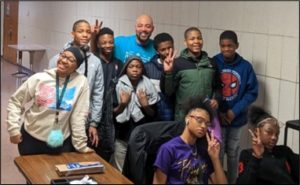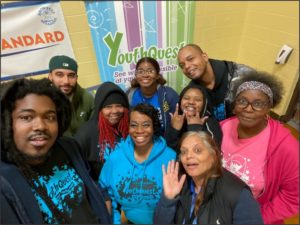In the prior two blogs, we talked about how a group of master afterschool teachers at 25 afterschool sites in Genesee County have responded to the pandemic years. One important area of evolution was the new service models that put staff in the field visiting homes and meeting parents at drop off sites, producing a wide variety of online activity content, taking activities outside and, for the first time, implementing a whole new regime of personally protective equipment (PPE) and cohorting practices. This was a lot of new stuff!
The other area of innovation was in the practices that were delivered inside of afterschool programs during the return to in-person schooling for the 2021-2022 and 2022-2023 school years. This was a finding from the 2021-2022 end-of-year evaluation reports for YouthQuest:
Finding 3. YouthQuest has a compelling afterschool impact story about mental health prevention…in most cases staff teams achieved a “very-low or no-error rate” – there were no moments of missed opportunity. Every challenge was noticed by adults and almost all were addressed in the moment…. Every comment from a child merited an authentic response from an adult, and every adult continuously set and reinforced high expectations for socio-emotional skills. [See report for YouthQuest]
There was a similar finding in the Bridges end-of-year report. And we’re not kidding about every instance: In our data, intentional co-regulatory events were happening at a rate of 10 per hour per staff person. The master afterschool teachers at these sites were standing up their best practices and skills to respond to an increasing proportion of stressed children.
AATI Practices
One of the key insights of the trauma-informed movement is to not mistake “misbehavior” (i.e., children not participating in the desired way) for children’s intentions. Children and youth who cannot keep their bodies in the activity space, who are frequently very worried about others, who simply can’t focus are likely enacting unconscious behavioral scripts that come from earlier ages and more stressful circumstances.
This means that, when children have been triggered in some way, they are projecting past-relevant emotions onto the current moment, and they are also acting out the behavior scripts that went with those past emotions. It is not because they want to or choose to. They don’t think about it. Its automatic.
We also use the term attachment-aware, which means being aware of the attachment skills that children bring into afterschool settings. Adult and youth attachment skills are what make up relationships between parent and child or teacher and child. In afterschool settings, the teacher brings the warmth and intent to care skills, and the child brings their prior experience at relationships with their own primary caregivers. It’s tough for an adult who is unknown to the child to effectively jump in to “have relationship,” or what we would call “co-regulate,” with children who are in the middle of acting out an energized script from an earlier time. It requires trust to help children change the focus of their awareness in that moment. Being “attachment aware” makes it possible to do the trauma-informed work of co-regulation with a “very-low or no-error rate.”
The formula is this: Adults are able to help children interfere with cycles of reactivity to the extent that a trusting relationship is achieved between the child and adult. In the next several sections, we tell four stories: Two about building children’s attachment skills and two about how teachers use their relationships to help students interfere with reactivity and integrate uncomfortable thoughts and feelings.
Attunement
One best practice that we observed across networks was staff who were prepared to completely change expectations for the activity depending on where the children were at emotionally. The priority was to reach a calm and respectful connection between the adult and each student. A great example was Keke, one of the most “Zen” youth workers I’ve ever observed, working with a group of eight 4th and 5th grade students to get started on an activity about storytelling. What’s important is Keke’s decision that attunement had to come first.
When, after 15 minutes of trying to get started, Keke realized that for perhaps half of the children there was simply no way to settle down and start the activity. It was time to go to the floor mat and get a little bit more physical with a game of hot potato spelling words. This kept things in the general area of literacy but lowered the task demands – storytelling was too hard in that moment.
This process was a struggle too, but it allowed children to interact with a warm adult and be able to fidget and laugh (sitting on the floor together in a circle) while that adult was warmly but unflinchingly asking each child what’s going on for them and asking the rest of the children to respectfully witness the statements and feelings of the child speaking.
This process took about 40 minutes and, by the end, several emotionally energized topics had been discussed (e.g., having enough money to buy bracelets at school, why not to physically attack someone who has mocked you, using hand sanitizer to feel safe from COVID germs while passing the hot potato, how to comply with any of several community agreements). Perhaps most importantly, one student who rarely pays compliments paid a compliment to another and the group, and all thought this was significant.
Everyone was more settled and feeling more connected by the end of hot potato spelling words. The storytelling never happened, a few spelling words were spelled, but most of the eight children had the warm experience of being the focus of an adult who genuinely wanted to know what they were thinking and feeling in that moment.
Collecting Children
Attunement is the process of an adult and child sharing eye contact and the adult reading the child’s emotional state and either mirroring what we call the broaden and build skill state or responding to a narrow and constrain skill state. In either case, attunement requires proximity to children who are willing to attune. At Brandon Nuby’s Holmes STEM Academy, collecting children operates as the state of the art – and uses an incentive/rewards system as the foundation of the practice.
To set the stage: Mr. Nuby had a group of perhaps 20 middle school aged newcomers to his program in fall 2022, particularly a large group of 7th grade boys. When I observed this group in fall 2022, the program had some moderate chaos, what some would call a tough group. However, because Mr. Nuby understands these 7th graders as little replicas of his own child self, he responds calmly with constant love and structure.
Part of that structure is the YouthQuest Bucks program – a way of earning bucks that can be used to buy things in the YQ Bucks Store and during amazing field trips that are a core part of the YouthQuest model. As Mr. Nuby stated in our fall 2022 interview, “I’ve got these kids coming to the program with YouthQuest bucks – we’ve been at our attendance limit almost every day, and I’ve been working on them.”
The socio-emotional skill growth, from year to year, was in evidence to me: A youth basketball game in the gym required constant supervision and frequently devolved into argument in fall 2021; that same group of students was able to self-organize into a 10-minute basketball game with few disruptions in spring 2022; by fall 2022, that same basketball game lasted 25 minutes and did not require a single adult support.
While it’s true that behavioral reward systems are effective for issues of basic regulation, like coming to the program every day, these systems are not what makes the basketball games get successively more well organized. This is the point of telling Mr. Nuby’s story. Mr. Nuby gets the kids attention with the YQ bucks – but it’s the attunement conversation that accompanies the exchange of bucks that matters for more advanced socio-emotional skill building. With every buck comes a conversation with Mr. Nuby or a member of this team who is handing out the bucks. Often, the staff are walking around with a handful of bucks at entry, and at other times during the program, collecting children.
Every student gets bucks at entry for coming each day, and each transaction involves a look in the eyes and a conversation about their feelings and how the day can go – a moment of emotional attunement for every student. The students, for their part, want to be collected, and look forward to the ritual of earning the YQ bucks as you can tell from the quote below (a composite from two eighth grade and one sixth grade student)
Most like the bucks because they have a lot of them stacked up. It’s very reasonable in how much we get each day; if you act up, your pocket gets hit. It’s like a good idea to get students to act right cuz, at the end, they get to go to a store to buy stuff… actual things that you would buy from a store…. If you have been acting up, he’ll tell you he is disappointed that you are going to get your money taken… and then, if you pick up the trays, he says thank you and good job. I’ve still got money from prior years at youth quest.

Mr. Brandon Nuby and Students at YQ Bucks Store, Brownell Elementary, Flint, Michigan
1-on-1 Nurturance
In the parenting literature, there are two terms that capture two important types of responsive adult behavior when parenting: synchrony and nurturance. Synchrony is when parents use encouragement to help children quickly generate positive emotions so they can return to the task, right in the moment (e.g., a child’s attention wanders, and an adult is there to bring it immediately back).
Nurturance is when parents use encouragement to help children downregulate negative emotion. When a parent decides that their child can’t keep going on the task, and child needs to stop for a check-in, it’s referred to as an adult’s act of nurturance. Nurturance, in this case, means making it 1-to-1 attunement for a moment and changing the child’s attention by modeling a broaden and build skill state and/or changing the circumstance in some way. These acts of co-regulation break the connection between the current circumstance (the trigger) and the child’s wandering attention, boredom, or overflowing emotion.
The 1-on-1 moment of nurturance was used most skillfully and intentionally in Fall 2022 at Brownell Elementary, where Miranda Manns has been site team leader the for the past 5 years. Miranda is a master afterschool teacher with extensive experience working in the positive youth development and trauma-informed approaches during her professional journey from parent volunteer to afterschool staff to program manager. When asked about the children who were struggling to manage their own bodies and emotions, the kids with their narrow and constrain skill engaged, Miranda replied:
We’re trying to get them to manage emotions and reminding them of things they had used in the past that worked when they were sad… and just always letting them know it’s okay to have negative feelings as well as negative attitudes but we have to manage them… something may have happened during the school day and they are still ruminating on it when they come in.
So, what happens at the intersection of stressed children in emotional overflow and staff who understand the attachment and trauma science? The first thing is completely consistent warmth and emotional containment from the staff. It didn’t matter if a single child was having a moment of meltdown, or if a group of children were having a moment of moderate chaos, the staff contained any reactivity they may have felt and continued to express high expectations with calm and caring body language and tone of voice.
The second thing that happened was lots of 1-on-1s where adults gave their mostly undivided attention to a child experiencing emotional reactivity and behavioral impulse. During our three-hour observation, nearly fifteen 1-on-1s were required by the five members of the staff team. Because our observation protocol included follow up questions, we know those 1-on-1s guided children toward mindfulness about their emotions because staff asked children what was happening for them in that moment, how they were feeling, and why.
Brownell also has a space for when the 1-on-1 needs a next step: the blue couch in the staff office. Miranda says:
“It’s almost like a healer or something, but once they sit on that couch… I’m not sure if its because I offered it or because they are actually able to get mindful and be at peace. The blue couch is the healer in this place, and I ask them if they need the famous blue couch or if they want to talk to Miss Manns about it.

Miranda Manns and Staff at Brownell Elementary, Flint, Michigan.
Mindful Tools
As we saw with the 1-on-1s and blue couch at Brownell, staff were guiding children in distress toward mindful responses to their own overflowing or uncomfortable feelings and behaviors. Mindfulness is all about being aware of some specific things in the present moment. This also means not thinking about the past or future – which is what people in our society spend most of their time doing – and why it’s good to spend time building your present-focusing muscles.
Mindfulness interventions are suggested for children and adults with multiple ACEs because survivors are more likely to be triggered into narrow and constrain mental skill states (e.g., invasive thoughts, hypervigilance, avoiding people/places/topics, hyperarousal) that accompany the familiar behaviors of withdrawal, frustration, and disruption of self/others. Children’s capacity for openness, curiosity, and play are “hijacked” by an activated narrow and constrain skill state.
There are a few general mindfulness practices that are frequently recommended to manage narrow and constrain skill states in education settings. The first practice is focusing awareness for the purpose of building your present-focusing muscles by, for example, practicing mindfulness exercises as a group in afterschool programs. The second important mindfulness practice is learning how to focus on feelings and sensations inside of the body. This ability to focus on internal sensations is also called interoceptive awareness. These two mindfulness practices have lots of application in educational settings.
Danielle, at Pierce Elementary School, uses mindfulness practices weekly with students. Danielle’s explicit goal is to teach interoceptive skills that staff and children can use during the 1-on1 moments of nurturance, right after behavior has gone off track and the adult approaches. But the muscle building part is the preparation for use, and this happens with the whole group. When the interoceptive and other strategies are taught and practiced with all of the children, the tools become part of the culture and can be reinforced by peers as well.
Here is a snippet of what it sounds like when Danielle is doing the whole group mindfulness work at Pierce. In this case, children are spread out on the gym floor, and they have just listened to some very chill music and a guided meditation about how to become an observer of your own emotional states using the analogy of a feelings-fish swimming in your own brain-body pond:
- Teacher States: …Feelings are fish – the fish are your feelings that can be angry, sleepy, happy, nervous… Your job is to be the pond. You are the pond, and you watch the feelings swim around. You can just notice those feelings. Can you be the pond? What do you notice?
- Sometimes we feel like we are angry – like the fish. But we are not the fish. We are the pond. So be the pond. When you feel like you are only an angry fish – remind yourself that you are not an angry fish; you are the pond. You are not your angry feelings; you are just noticing them.
- Teacher Question: So does anyone have any thoughts? Student Responses: I liked breathing in and breathing out (and other students echo). I liked that I got to lay down. I liked the fish.
This is subtle and powerful work. During the guided meditation, the children were quiet and guided to a mindful state by a story about a feelings-fish. The mindful state was a present-focused one, with students noticing their own feelings and seeing them as fish in their brain-body pond. This is direct practice at integrating charged emotional energy before it gets stronger – even before thinking about why I feel that way, I can try put myself in the position of observer rather than reactor. Another key point is that children don’t have to fully understand the process to get the benefits.
While practicing and building mindful muscles is a weekly part of program, its during the 1-on-1s that Danielle sees the tools and practice pay off. Specifically, when students have emotion/behavior challenges that fall outside of community agreements, students are given a 1-on-1 moment and a paper form that structures a process of “think and reflect” about “big emotions.” Daniel described an example of how it worked with one student this year, when…
… one day instead of following the same behavioral pattern of not regulating emotions, taking it out on others, throwing tantrums when upset, she began to self-regulate using the outline she had worked through so many times using the think sheets. This last time she became upset she asked to come to my office so that she could gather her thoughts to go have a constructive conversation with the other student… She then politely asked them for her things back and made it a point to ask the other student not to repeat the behavior, and instead, that if they asked nicely she would lend it to them.
The Future of Afterschool
The field of afterschool has evolved quickly since March 2020. Some new practices and possibilities developed in response to the pandemic yeras, from the pressing of resources at hand into the shape of urgent new needs. These new practices may spell out the future of afterschool services and the role of afterschool teachers in the post-pandemic period. As we noted in the first blog, the pandemic era saw the development of new service models that put afterschool teachers into new, externally-facing roles and relationships with children and families, depending on need.
But the innovation also happened on the inside. New practices from the attachment aware, trauma-informed perspective also came into more frequent and intentional use. While staff at most of the sites are now using many variations on these practices (e.g., heightened warmth, mindfulness techniques, proactive check-ins, tactile and safe space options, etc.), we in afterschool lack a common standard for responding to children with post-traumatic stress symptoms and/or developmental delays. These are practices that afterschool may want to add to quality standards, particularly during and after exposure to traumatic events and particularly for communities where exposure to traumatic events is more frequent or intensive (e.g., gun violence, climate disaster).


